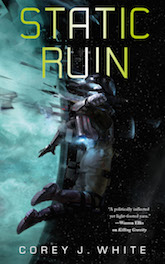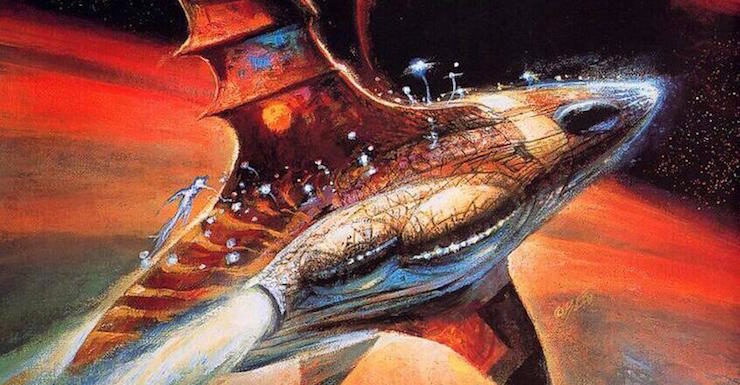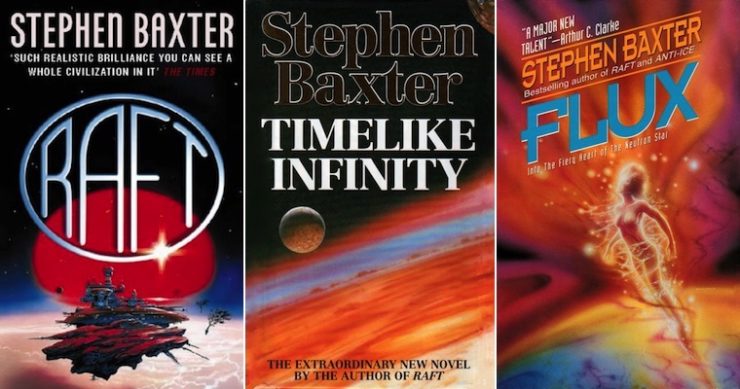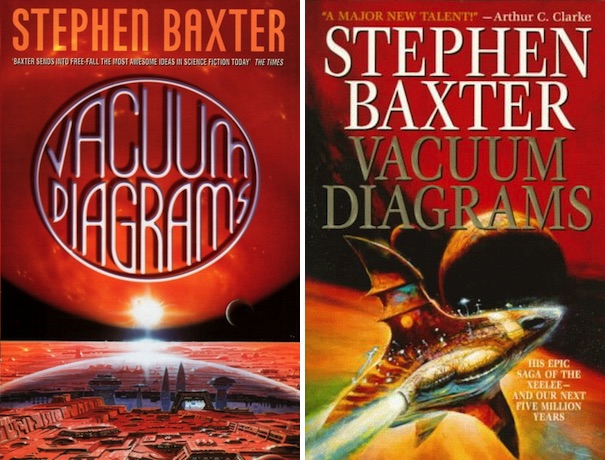In this bi-weekly series reviewing classic science fiction and fantasy books, Alan Brown looks at the front lines and frontiers of the field; books about soldiers and spacers, scientists and engineers, explorers and adventurers. Stories full of what Shakespeare used to refer to as “alarums and excursions”: battles, chases, clashes, and the stuff of excitement.
In the mid-1990s, many of my favorite authors were reaching the end of their careers, slowing down and writing less, and I was looking for new things to read. One of the authors who caught my eye at the local Waldenbooks was Stephen Baxter, a British writer whose work was just being published in the United States. His stories were epic in scope, rooted in the latest scientific theories, and full of the sense of wonder I was looking for. This was not an author who shied away from big ideas: His Xeelee series spanned not just the history of the world, or even the galaxy, but instead looked at the history of the universe itself, and the ultimate fate of humanity. His stories often left me dizzy and disoriented, as my mind attempted to grasp concepts that I had never previously considered.
Vacuum Diagrams is a collection of stories related to the Xeelee series of novels, which include Raft, Timelike Infinity, Flux, Ring, Xeelee: Vengeance, Xeelee: Redemption, and additional story collection, Xeelee: Endurance. The series also includes the Destiny’s Children sub-series of three novels—Coalescent, Exultant and Transcendent, and one short story collection, Resplendent.
On “The Manifold” website, Baxter had this to say about a suggested reading order for his works: “I hope that all the books and indeed the stories can be read stand-alone. I’m not a great fan of books that end with cliff-hangers. So you could go in anywhere. One way would be to start with ‘Vacuum Diagrams’, a collection that sets out the overall story of the universe. Then ‘Timelike Infinity’ and ‘Ring’ which tell the story of Michael Poole, then ‘Raft’ and ‘Flux’ which are really incidents against the wider background, and finally ‘Destiny’s Children,’ if you can stand it!” So, even though Vacuum Diagrams is full of spoilers for the novels, Baxter himself considers it a good starting point. If, however, you want to avoid those spoilers and read the books and stories in the order of their internal chronology, Baxter has provided a timeline on his own website.
About the Author

Stephen Baxter (born in 1957) is a British science fiction author known for stories with a grand scope. He has degrees in mathematics, management, and engineering, and worked as an educator before he became a full-time writer. Because of his willingness to explore grand and ambitious topics, he is often seen as a spiritual successor to two other British authors, H. G. Wells and Arthur C. Clarke. In the thirty or so years since his first publication in Interzone, he has been quite prolific. The bulk of Baxter’s work has been in the Xeelee Sequence that is the subject of this column, although he has written numerous other books not connected with that series, including alternate histories. He has written authorized sequels to Wells’ The Time Machine and The War of the Worlds, co-authored a trilogy with Clarke, and co-authored five books with Terry Pratchett. And I found his Doctor Who novel, The Wheel of Ice, to be one of the most satisfying books tied to that TV series. His works have won a multitude of awards, including four British Science Fiction Association (BSFA) Awards, two Philip K. Dick Awards, the John W. Campbell Award, and one Hugo nomination.
Everything Old is New Again—A Short History of Science Fiction
Stephen Baxter has frequently been mentioned one of the prime exemplars of a resurgence of both hard science fiction and of space opera. To test those assertions, I did a quick review of the history of the field, which I will summarize here. I would caution that any attempt to put the genre into neat boxes requires making some sweeping generalizations, and that in a few paragraphs, I am leaving a lot out. My primary resource was a pair of anthologies from Tor Books, and editors David G. Hartwell and Kathryn Cramer: The Hard SF Renaissance from 2002, and The Space Opera Renaissance from 2006. Baxter’s work appears, and is discussed in, both anthologies.
Around the turn of the century, a number of critics and anthologists argued that science fiction was returning to its roots, to what is called “hard” science fiction, or fiction that centers on science, engineering, and problem-solving. At the same time, others were arguing that the field was returning to the days of “space opera,” or grand, sweeping narratives that focus more on adventure than on science. And because of the overlap between those two loose categories of science fiction (you can have good adventure stories with good scientific underpinnings), you can make a solid case that Baxter fits squarely in both camps.
The earliest proto-science fiction, before this type of literature had its own name, came from authors like Mary Shelley, Jules Verne, and H. G. Wells, who began to explore the impact of technology on the world in their work. It was only in the days of the pulp magazines of the early 20th Century that science fiction developed a distinct identity as a separate genre of fiction. And while there was science in the stories, it was often not rooted in reality. Stories instead focused primarily on adventure, as in the planetary romance stories of Edgar Rice Burroughs and Leigh Brackett, and on evoking a large scope sense of wonder, as in the space opera stories of E. E. “Doc” Smith and Edmund Hamilton.
In the “Golden Age” of science fiction, a period that spanned the 1940s and 1950s, and defined to a remarkable extent by the John Campbell-edited Astounding (later Analog) Science Fiction, the focus shifted to more realistic science and engineering, and stories built around scientific puzzles and problem-solving—a sub-genre that became known as hard science fiction.
Buy the Book


Static Ruin
Then, in the 1960s, there was a conscious rebellion against the old styles of science fiction by people who scorned its lack of literary merit, and what they saw as infantile wish fulfillment in its plots and storylines. The movement became known as New Wave science fiction, with its main standard-bearers appearing in the British magazine New Worlds, edited by Michael Moorecock. In the U.S., one of the leading salvos against the science fiction status quo was the landmark anthology Dangerous Visions, edited by the always subversive Harlan Ellison. Any discussion of the 1960s also has to consider the fact that the paperback publication of J. R. R. Tolkien’s Lord of the Rings led to a new genre of fantasy fiction, which would eventually grow to rival the entire science fiction field in size and influence. Starting around the same time, a wider audience was increasingly being exposed to tales in the space opera tradition, especially in popular entertainment, thanks to TV shows like Star Trek and movies like Star Wars, among many others.
In the 1980s and 1990s, the sub-genre of cyberpunk, which explored the growing influence of computers and the emergence of virtual worlds and was marked by stories with a noir sensibility, followed in the footsteps of the New Wave. At the same time, growing numbers of authors, with far better writing skills than their forebears, were returning to the older, more traditional themes of science fiction and breathing new life into them. In their hands, the term space opera ceased to be a pejorative, and hard science fiction, while keeping its scientific rigor, lost some of its clichéd nature. In Britain, this included writers such as Iain M. Banks, Alastair Reynolds, and Stephen Baxter, while in the United States, it included writers like Vernor Vinge, Gregory Benford, David Brin, Greg Bear, and Lois McMaster Bujold.
Today, while I agree that there are a lot of writers, like Stephen Baxter, whose work participates in the space opera and hard science fiction traditions, I would not say that any particular sub-genre currently dominates the field. There is room for a wide diversity of styles and approaches to the literature of the fantastic. And for those, like me, who enjoy good, old-style science fiction, there is plenty to choose from.
Vacuum Diagrams
The book opens with a bridging story where, through an alien experiment (and via an avatar of his dead wife, Eve), a man is given a view of the entire history of mankind. The stories are grouped together to represent the grand eras of human civilization.
The first group of stories, entitled “Expansion,” are largely hard science problem-solving narratives and feature encounters with new life forms in strange places, as mankind works to knit together the solar system with a network of wormholes. Included here are tales such as “The Sun-People,” “The Logic Pool,” “Gossamer,” and “Cilia-of-Gold.” One of the most moving stories in the collection, “Lieserl,” is a story of an artificially-born woman pushed through an accelerated lifespan so that her consciousness can become a template for a new form of being who can survive in the heart of the Sun and gather data for researchers. The story mixes both tragedy and transcendence in equal measure.
The stories representing the era of “Squeem Occupation” include “Pilot,” which follows a group of humans fleeing the invaders and shedding their very humanity in an effort to survive. “The Xeelee Flower” is Baxter’s first published story, which appeared in Interzone in 1987. The author himself comments on this tale—out of which grew the entire Xeelee series—on his website, explaining: “The core of Xeelee Flower was the central jeopardy situation: I had an image of an astronaut, stranded in orbit around a sun about to go nova, sheltering behind an energy-soaking ‘umbrella’. To develop the idea I did some technical research, to figure out just how much each square metre of the umbrella would have to absorb. But I also figured out the background: Who was this guy? How had he got stranded there? Where did the ‘umbrella’ come from? I came up with the notion of powerful off-stage aliens called the Xeelee (I can’t remember where I got the name), whose purloined artefact, the Xeelee Flower itself, would save my hero’s life. Accompanying this was the vague idea of a Galaxy full of minor species, including ourselves, living in the shadow of the Xeelee.”
The next two stories, “More Than Time or Distance” and “The Switch,” shows us the impact that even Xeelee artifacts have on humanity.
The first story from the era of “Qax Occupation,” “Blue Shift,” is very reminiscent of Larry Niven’s tales of Beowulf Shaeffer, and follows a man hired by the Qax to pilot a new type of starship to investigate the Great Attractor, which turns out to be a massive ring, an artifact built by the mysterious Xeelee. “The Quagma Datum” is another tale of an explorer who finds a way to survive what his cynical employer clearly expected to be a suicide mission. And in “Planck Zero,” a human visitor observes a grand advanced physics experiment by the race called the Silver Ghosts that goes terribly wrong.
In the era of “Assimilation,” humans dare to compete with the Xeelee, working to incorporate every other race into a massive empire. In “The Gödel Sunflowers,” humans explore a mysterious artifact they call the “snowflake.” In “Vacuum Diagrams,” a mysterious man named Paul appears and helps researchers find the secret of an object they call the “sugar lump,” which turns out to be a vast repository of Xeelee power.
In the era of “The War to End Wars,” mankind scatters through the stars as they begin to attack the Xeelee directly. In the stories “Stowaway” and “Hero,” humans struggle to survive in an alien environment. “The Tyranny of Heaven” is one of the most memorable and horrifying stories in the collection. It follows a young missionary traveling with a human fleet who discovers a terrible secret—one that turns everything he once believed into a lie.
The era of “Flight” is represented by only a single story, “Secret History.” The entity Paul, who has transcended humanity, sees the ultimate goals of the Xeelee, and realizes the true struggle is not between humans and Xeelee: it is between all baryonic life and the mysterious photino birds that consist of dark matter, who have very different plans for the universe.
Finally, in the era of “Photino Victory,” when the photino birds begin to reshape the universe to their own ends, we have three stories: “Shell,” “The Eighth Room” and “The Baryonic Lords,” and an epilogue, “Eve,” which reveal to us the ultimate fate of mankind. I will leave this for readers to discover, because if anything in this world qualifies as a spoiler, it is the ultimate fate of mankind.
Final Thoughts
Stephen Baxter has built a solid career producing good old-fashioned science fiction with a contemporary sensibility, establishing himself as one of the first rank of science fiction writers along the way. This collection, which spans an entire history of both mankind and the universe itself, is dizzying in its scope. It puts a variety of characters into compelling situations that involve principles from the borders of current science, and gives us space battles that rival the epic narratives of the early pulp magazines. At the same time, these stories represent only a tantalizing glimpse of the full scope of Baxter’s future history, with all its mysterious races and massive plans and artifacts.
Now, it’s your turn to comment: If you’ve read Vacuum Diagrams, or Baxter’s other tales in the Xeelee Sequence, what did you think of them? What are your thoughts on any other works by Baxter, beyond this series? And do you agree with the assertion that Baxter is one of those who has revitalized the sub-genres of hard science fiction and space opera?
Alan Brown has been a science fiction fan for over five decades, especially fiction that deals with science, military matters, exploration and adventure.













I read a fair amount of Baxter back in the day — the initial Xeelee books (the first four novels + Vacuum Diagrams), the Apollo books (Voyage, Titan, Moonseed) and The Time Ships. I enjoyed all of them (although Titan in particular is grim). The Time Ships and Timelike Infinity/Ring hit at a point when I was very much in the mood for the sort of books that cover impossibly large spans of time & space, and possibly include wars waged by alien species throwing galaxies at each other. (Kind of like if Olaf Stapledon and Doc Smith had a baby.) Someday I should go back and get caught up on the Xeelee books, at least.
[edited to correct the title of Voyage, which I always want to call Mars]
I too read quite a bit of early Baxter: he seemed to be the equivalent and/or successor to of the American “Killer B’s” with added Stapledon and bonus British miserabilism. I remember quite a few concepts which were novel for the time, which makes me wonder how the early Xeelee books hold up. On the one hand I think there have been some soft reboots along the way but on the other Raft, the first book, is now part of the SF Masterworks line.
I think that the overall state of US hard SF and space opera had been improving for quite some time before Baxter under the aegis of editors such as Bova and Baen. I don’t think that spread to my side of the Atlantic until people like David Pringle became prominent in the 80’s. (British snobbery towards American SF is significant and not always merited.)
Oh, and when I was reading those first four Xeelee books, Flux and Raft always seemed like kind of odd outliers — set in the Xeelee universe, but kind of odd side stories in a more Hal Clement/Robert Forward mode. Although did they get looped back into the main storyline in Ring?
Back in the 90’s every other book I read seemed to be a Baxter book. I love grand well written space opera and he hit that spot (along with all those you mentioned above). I never cared for his alternate NASA tales (what I call his Voyage/Titan sequence), but I did enjoy the duology starting with Flood and the Xeelee stories remain among the best New Space Opera books I have read. The Manifold stories left me cold but much of his short fiction are lovely quiet little gems of character based around an SF idea.
The Time Ships (his only Hugo nomination – and I say shame on the fans who haven’t nominated him more!) is excellent as are the Destiny’s Children series. I don’t read him as much these days but I do have the Xeelee Series on my list to re-read soon. As soon as I have a whole lot of time!
Bob
I read this when I was like ten and it blew my god damned mind. I believe it was my first or second Baxter book, after which I read pretty much everything he’s written.
@1 “Kind of like if Olaf Stapledon and Doc Smith had a baby.” I like that, and it does a good job of capturing his style!
@2 I had never heard the term “British miserabilism,” but it does sum up a common difference between British and American space opera. British authors are more willing to face the fact that all things must come to an end at some point.
@3 I have read the first four books, but don’t remember how they fit together, just bits and pieces. Someone with a better memory than I will have to answer that question.
@@.-@ Putting together the article, I found a couple of Baxter books that I hadn’t previously seen, and new Xeelee books as well. I, too, have more reading to do.
@5 I can’t imagine reading Baxter at ten years old. I was forty when I first encountered him, and he still blew my mind!
I’ve read everything I can find by Baxter in the US (and that’s less than you can find in GB, aggravatingly), and he’s developed into one of my favorites. Partly it’s because of his scope, which as you say reaches all the way to the ends of our universe. Partly it’s because while the characters that drive the plot (like Michael Poole) are rather crudely-drawn, larger-than-life carboard cutouts (not necessarily a bad thing), Baxter takes time to show how their history-changing internal drives affect the smaller players in the drama, usually to their detriment.
But my favorite aspect of his writing is how melancholy his plot treatments can be, with humans often and ultimately on the wrong side of a very long history. That humanity’s spirit strives on even in the face of winning the battles but not the wars, whether driven by those singular heroic figures, or by minor never-knowns toiling in the quiet and desperate spaces, is uplifting and sad at the same time, and shows a depth and complexity to his writing that to me stands out among hard-SF authors.
I read Vacuum Diagrams and found things to like in it – Cilia-of-Gold stuck with me in particular as an interesting piece of world-building – but, for no specific reason that I can recall, never picked up any of Baxter’s novels. My sense was that these stories were more of a throw-back than the US “Killer B’s” work (although, not in a bad way).
I associate Baxter more with the hard SF camp than space opera. Possibly that’s a result of only reading his short fiction.
Baxter’s biggest problem to me was the unrepentant incompetence of his characters. It’s the opposite of Campbellianism: no matter what the threat, humanity will not only fail to rise to it but usually completely ignore it and get hopelessly slaughtered. This might be realistic (hello, the wondrously unified human response to global warming) but it does, after the tenth repetition, get a bit tiresome. Now and then we see people manage amazing things and then inevitably get all their plans totally wrecked by the incompetence and/or venality of everyone around them. Miserabilism indeed. The other currently-writing British SF authors do mostly admit of some light in their darkness, even if they can’t all be Iain M. Banks (who could also do miserablism if he wanted to, but he mostly didn’t), but Baxter just gets depressing to read sooner or later.
One wonderful consequence of Baxter’s writing is that it let our own James Nicoll do some of his most cuttingly acerbic reviews. His review of the short story _Mayflower II_ is particularly superb.
I own a ton of his books but am blown away by the limited audiobook options for his works. It sucks! What do we have to do to get Vacuum Diagrams and Raft in Audible form!? Seriously, can someone provide an update? They just reprinted Raft, where’s the audiobook version!?